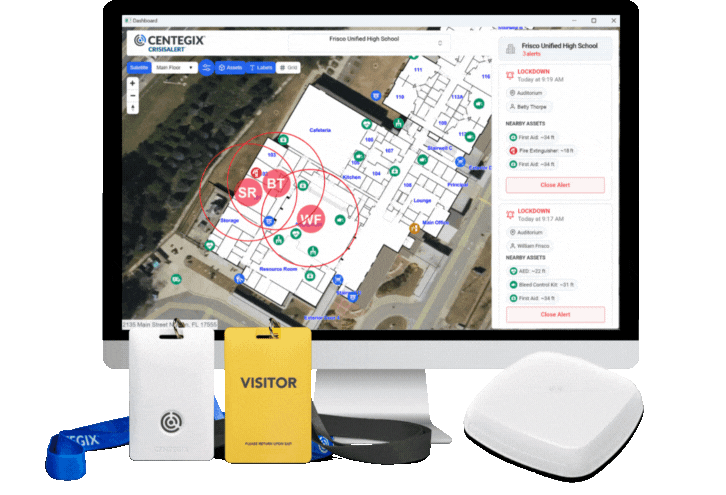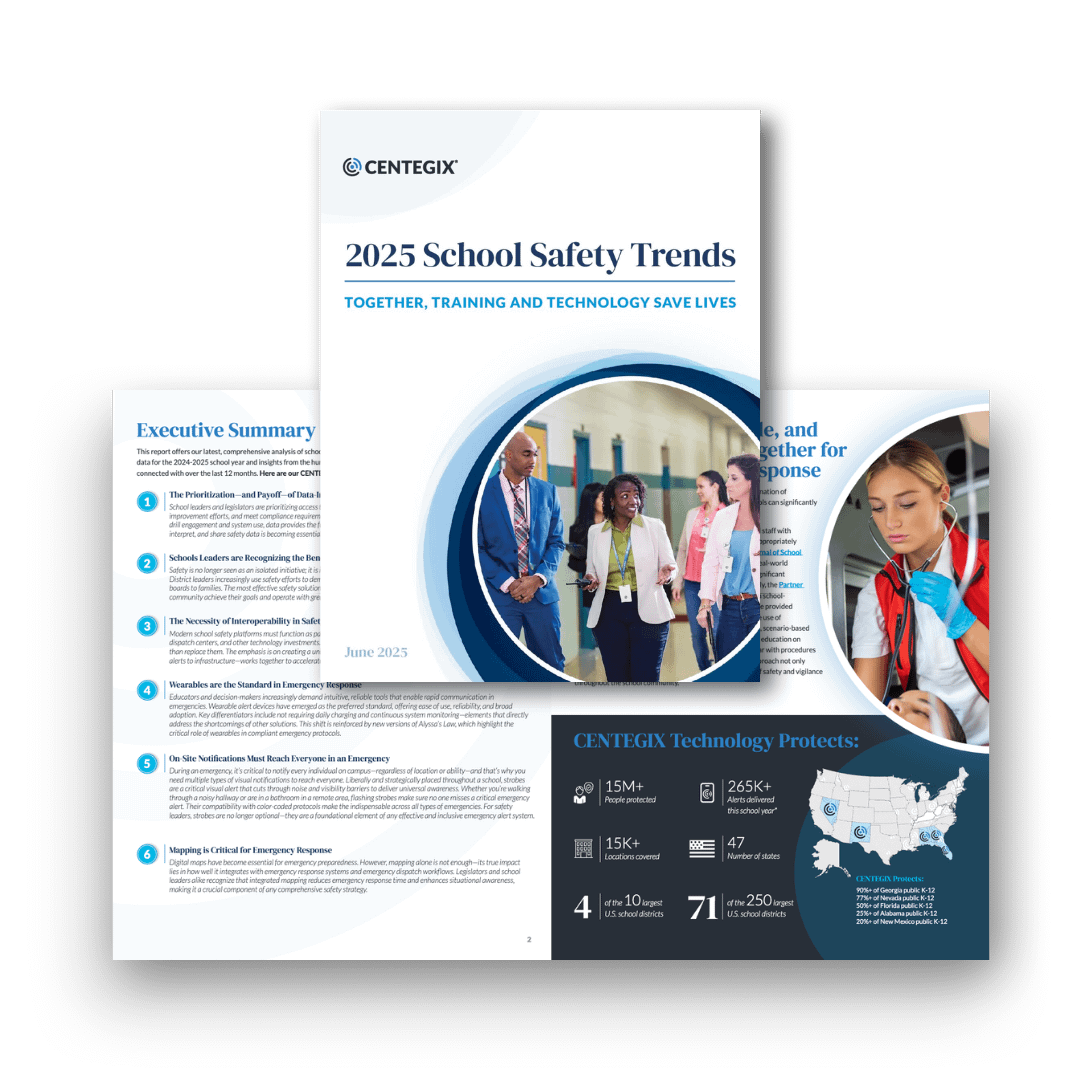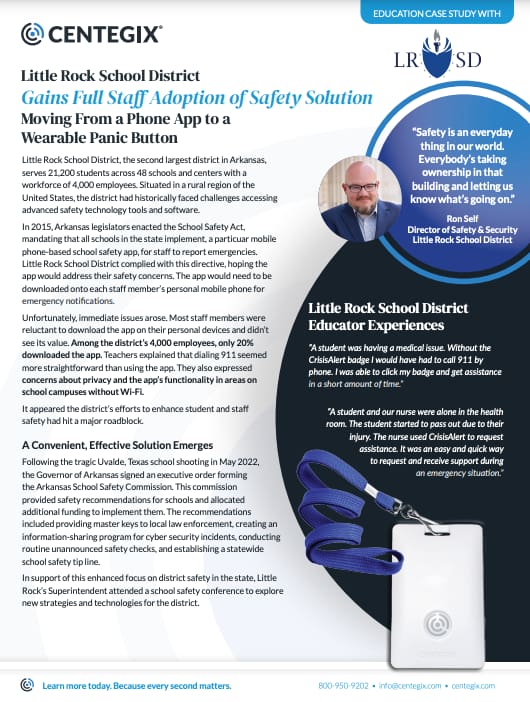CENTEGIX | Education
Arkansas School Safety Standards
CENTEGIX | Education
Arkansas School Safety Standards
CENTEGIX | Case Study
Little Rock School District Gains Full Staff Adoption of Safety Solution
Learn about how Little Rock School District in Little Rock, Arkansas, adopted the CrisisAlert solution to improve comprehensive safety for their 21,000+ students across 48 school sites and gained full staff adoption in our free case study. Download your copy today →
Arkansas Proposes Alyssa’s Law: HB1492
In February 2025, the Arkansas House introduced HB1492, an act to require Arkansas schools to provide all school employees with a wearble panic alert system device “that allows the individual to immediately contact local emergency response agencies.”
The legislation, if passed, would require all public school districts and open-enrollment charter schools to implement a wearable panic alert system in each public school within its public school district or open enrollment public charter school system that 1) integrates with local Public Safety Answering Point infrastructure to transmit 911 calls and mobile activations; and 2) can initiate a campus-wide lockdown notification.
Arkansas LEARNS Act
On March 8, 2023, Governor Sarah Huckabee Sanders signed Act 237, known as the Arkansas LEARNS Act, into law. Intended to bring sweeping changes to Arkansas’ education system, the law covers a broad range of topics, including everything from school vouchers, to increased pay for teachers and higher literacy standards for elementary students, to safety training and resources. The law includes a focus on school safety.
Prioritize school safety by focusing on physical security, additional resource officers, mental health, and training to implement best practices.
School Safety Commitments
The Arkansas Department of Education (ADE) will accomplish their school safety goals through the following commitments:
- Distribute funds for improvements in safety measures: Continue to oversee the implementation of the $50 million of grant funding to provide resources for districts as they implement ADE’s safety priorities.
- Expand new Safe Schools Unit to support districts: Expand the new Safe Schools Unit to provide direct support to districts as they put into place new procedures. This unit will be instrumental in providing direct support, professional learning, monitoring, and direction regarding school safety.
- Develop best-practice crisis response plans: Develop a statewide crisis response plan that identifies the roles and responsibilities of each actor (state and local partners) in time of a crisis and support districts to create a local crisis response plans.
Arkansas Center for School Safety
The Arkansas Center for School Safety (ACSS) provides education, resources, training, and more to educators and law enforcement professionals in Arkansas to help them in providing our students with a safe, supportive learning environment to reach academic success.
Safe Schools Intiative Act (Ark. Code § 6-15-1303)
The Safe Schools Initiative Act (Ark. Code § 6-15-1303) details the responsibilities of Arkansas school districts regarding school safety and emergency response plans. There are several key areas of responsibilities.
ACSS Catalog
The Criminal Justice Institute and the Arkansas Division of Elementary and Secondary Education (DESE) have partnered to create a robust catalog of basic and specialty school safety training courses, available to law enforcement and school personnel such as administrators, teachers, staff, counselors, and school security officers.
The Arkansas Center for School Safety uses practical, hands-on application and classroom-based instruction together in a myriad of topics that increase knowledge and skills pertaining to school safety issues.
Some of the topics covered include professional development for school resource officers, safety and crisis planning, active shooter response, drugs on campus, gang awareness and intervention, and bullying awareness and prevention.
Learn more here.
Key Responsibilities
School Safety Assessments: Each school district in Arkansas must conduct a comprehensive school safety assessment every three years. It should include an assessment of the following:
- Safety and security of the site and exterior of buildings
- Access control
- Safety and security of the interior of buildings
- Monitoring and surveillance, including without limitation type and extent
- Communication and information security
- Review of emergency operation plans
- School climate and culture
School Safety Plans: Each school district in Arkansas must develop and maintain a comprehensive school safety plan. This plan must address various aspects of school safety, including but not limited to emergency response procedures, crisis management, prevention and mitigation strategies, and communication protocols.
Collaboration and Input: The law emphasizes the importance of collaboration and involvement from various stakeholders in developing the school safety plan. This includes input from school administrators, teachers, parents, law enforcement agencies, and other relevant community organizations.
Annual Review and Updates: School districts are required to review and update their school safety plans at least once a year. This ensures that the plans remain current and effective in addressing evolving safety concerns.
Training and Drills: The law mandates that school personnel, including teachers and staff, receive appropriate training on emergency response procedures and crisis management. It also requires schools to conduct regular safety drills, such as fire drills, tornado drills, and lockdown drills, to familiarize students and staff with the appropriate actions to take during emergencies.
Reporting Incidents: School districts must establish a system for reporting incidents that pose a threat to the safety and security of students and staff. This may include procedures for reporting bullying, harassment, violence, or other concerning behaviors.
Coordination with Law Enforcement: The law encourages school districts to collaborate with local law enforcement agencies to enhance school safety efforts. This may involve establishing partnerships, sharing information, and coordinating response plans.
Grants for Arkansas School Safety Solutions
Stronger Connections Grant
In late 2022, the U.S. Department of Education announced nearly $1 billion in awards through the Bipartisan Safer Communities Act (BSCA). In Arkansas, the Stronger Connections grants aim to provide students with safe and supportive learning opportunities and environments critical for academic success.
Through the BSCA, Congress awarded $1 billion in funding to state educational agencies (SEAs) to develop state grant programs to give students safer and healthier learning environments. The BSCA specifies that SEAs must award these funds competitively to high-need LEAs, as determined by the state.
This grant focuses on helping schools foster sustained learning, engagement, and attachment for students in Arkansas schools. The Stronger Connections Grant Program mandates that schools should accomplish this by becoming more resilient, supporting mental health, and improving school climate.
According to the Department of Education, schools should spend Stronger Connections Grant Program funds to:
- Implement evidence-based strategies that meet students’ social, emotional, and mental well-being needs.
- Create positive, inclusive, and supportive school environments.
- Increase access to place-based interventions and services.
- Engage students, families, educators, staff, and community organizations in selecting and implementing strategies to create safe, inclusive, and supportive learning environments.
- Design and implement policies and practices responsive to underserved students, protecting student rights, and demonstrating respect for student dignity and potential.
Examples of spending that qualifies for funding include hiring counselors and nurses, expanding mental and behavioral health services, providing teacher training on inclusion and behavioral interventions, and other related efforts to create a positive and supportive climate in Arkansas schools.
COPS School Violence Prevention Program
The U.S. Department of Justice oversees the COPS School Violence Prevention Program. The money is earmarked for evidence-based school safety programs and technology.
Schools can use those funds to purchase school safety technology that helps identify potential dangers. The money can also be used to improve emergency notification and response systems. To learn more, visit the COPS website.
BJA’s STOP School Violence Program
The U.S. Department of Justice also has funds available through the Bureau of Justice Assistance. BJA’s STOP School Violence Program funds software that helps K-12 schools maintain a safe environment. It’s geared toward recognizing, responding to, and preventing violence on campus. Learn more here.
Federal Grants
The list of federal grants awarded to Arkansas for the 2022-23 school year includes:
- IDEA ARP: $24,474,391
- IDEA: $157,959,371
- Title I: $354,297,729
- Title IV-A: $11,752,441
How Are Your Resources Being Spent?
CENTEGIX protects over 15,000 locations across the country. We can protect yours, too.
The CENTEGIX Safety Platform™, featuring CrisisAlert™, accelerates your response to emergencies. We’ve built the CENTEGIX Safety Platform to support you in the single most critical factor of incident response: time.
Discover federal resources to fund new safety and security initiatives in your district by exploring federal funding resources for school safety.

CENTEGIX Safety Report
2025 School Safety Trends: Together, Training and Technology Save Lives
Discover our latest, comprehensive analysis of school safety incidents gathered from the CENTEGIX Safety Platform™ usage data for the 2024-2025 school year, as well as insights from the hundreds of school safety and district administration leaders we’ve connected with over the last 12 months, in our report 2025 School Safety Trends: Together, Training and Technology Save Lives.
Download your copy today.

Customer Spotlight
Little Rock School District Upgrades Security Ahead of School Year
Little Rock, AR
The focus on safety has increased in recent years, and as the new school year starts, we looked at some new changes in Central Arkansas’s largest school district, including the addition of the CrisisAlert solution.
Little Rock Public Schools
Little Rock, AR
Learn about why Little Rock Public Schools chose CENTEGIX’s CrisisAlert solution as part of their new efforts to increase school security to help keep their staff and students safe.
Central Arkansas Library System
Central Arkansas
The Central Arkansas Library System has chosen CENTEGIX’s CrisisAlert solution to protect the staff and patrons across all 14 branches throughout central Arkansas.
Hear from Our Educators
We engage with teachers and staff every day to understand how CrisisAlert supports them, and here’s what they’ve shared:
A student was having trouble breathing and her vision was beginning to black out. We don’t have service in our building and it can be difficult to get ahold of the office staff, so having something to immediately alert them of emergency was incredibly helpful in a very scary situation.
I had a student who was refusing to follow directions and became very defiant. This student was beginning to get aggressive. I used my badge to alert our campus security monitor to remove the student from the situation. It is a very useful tool when the response was as immediate as it was.
A student was having a severe panic attack, trouble speaking, crying, not able to answer my questions as to what was wrong with her. I used the device to call for administrative help and it worked like it was designed to. Help arrived in a matter of seconds. I saw firsthand how well it works.
Championing Safe Schools with Educators and Educator Associations









Discover the Safety Platform
Safety solutions that prioritize speed for the best outcome.
Mapping and locating capabilities provide the precise location—of emergencies, visitors, and safety assets.
A visitor management system screens and locates visitors on your campus.
Protocol development to plan for rapid incident response.
CrisisAlert Is in a Class of Its Own
We don’t just raise the bar. We built it.
CrisisAlert leads the industry in wearable panic button technology. As the most trusted, proven, and deployed solution on the market, it delivers unrivaled reliability, redundancy, notification, and response capabilities.
Unlike other wearable panic buttons, CrisisAlert activates a fully integrated emergency response and notification system, including flashing strobes, intercom announcements, and computer screen takeovers. It’s the only solution with 100% campus-wide coverage that immediately sends a digital map to first responders with precise location details, down to the exact floor and room, detailing every safety asset in proximity of the alert, to protect your staff wherever they are.

Empower Your Educators
with Safety
Explore More Safety Resources
2025 School Safety Trends Report
This report offers our latest, comprehensive analysis of school safety incidents gathered from the CENTEGIX Safety Platform™ usage data for the 2024-2025 school year.
Visitor Management: Best Practices for Your School Safety Plan
CENTEGIX empowers thousands of schools to take control of their visitor management and protect their teachers, students, and staff. Get a copy of our Visitor Management Best Practices Guide today.
Supporting the Unique Safety Needs of Special Education Students and Staff
In our case study, learn how Meade County School District has supported and empowered their special education staff and students with the CENTEGIX Safety Platform™.
School Safety Standards by State
Schools in any state can meet school safety grant funding requirements by choosing the CENTEGIX Safety Platform™. Learn more about school safety in your state.

Creating Safer Environments: Leadership Strategies to Prevent Workplace Violence in Healthcare
Violence in healthcare isn’t just a growing concern—it’s a persistent crisis. Get actionable insights for leaders ready to fight workplace violence in this AHA Associate Podcast.

Reliability is Key to Effective School Safety Solutions
CENTEGIX CrisisAlert is a reliable school safety solution that reduces response times and creates a culture of safety in schools.

How to Comply with Alyssa’s Law in Washington
CENTEGIX CrisisAlert wearable panic buttons enable Washington schools to achieve compliance with Alyssa’s Law, SB 5004.

Board Chair POV: CENTEGIX is the Best Choice for Student Safety
Former DeKalb County Board Chair endorses the CENTEGIX Safety Platform as the best choice for creating safe schools.
SOLUTIONS
INDUSTRIES
RESOURCES
COMPANY
PARTNERS
CONTACT
EVERY. SECOND. MATTERS.®







